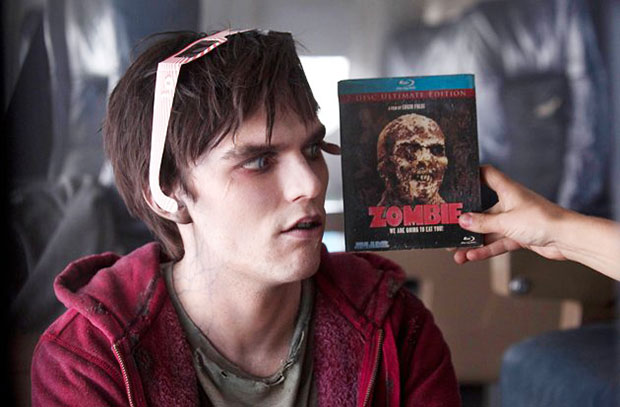
Fandom is a funny thing. Often, if the fervor toward a given subject — or in our case genre — is strong enough, fans become advocates, and advocates can become crusaders. That is not meant as a slight — furious debates in which film fans engage is often a reflection of thoughtful theoretical analyses. Horror fans are not immune to fierce defenses of dogma; indeed they are arguably the most stalwart.
Take Warm Bodies. In the film, a zombie falls in love with the girlfriend of one of his victims, and slowly regains his humanity through their relationship. Zombie purists have been decrying the film from trailer one, citing it as an affront to canon.
RELATED: ‘Warm Bodies’ Exclusive: Nicholas Hoult on Eating Tina Turner’s Brain
The ugly, shambling, worm-ridden truth however is that there is no zombie canon anymore. The mythos has been rehashed and reinvented so many times that even the zombie model to which we steadfastly cling is a reconfiguration. Perhaps it would be best to look at the benchmarks in the evolution of this classic cinematic monster to illustrate that there has never been a solid rulebook.
The Voodoo Zombie
The origins of the walking dead go back to ancient voodoo beliefs centering on the ability to resurrect the dead. Most commonly associated with Haiti, the roots go back as far as tribal Africa. This historical mythology is the basis for some of the very first zombie films. Bela Lugosi’s 1932 classic White Zombie plays upon this origin, as does Jacques Tourneur’s unsettling I Walked with a Zombie.
RELATED: Rob Corddry Would Not Let His Daughters Date a Zombie — VIDEO
These zombies did not consume their victims, they were the victims; reanimated in a stupor in order to engage in manual labor. At a time when the censorship was oppressive, the idea of anyone coming back from the dead was enough of a shock for audiences without the added cannibalism. The voodoo connection has not been entirely lost in subsequent decades, 1974’s Sugar Hill and 1988’s The Serpent and the Rainbow, but for the most part, this cultural derivation of zombie lore is dead and buried.
The Zombie We Know and Love
When there is no more room for convention, Night of the Living Dead will be unleashed upon the Earth. The conceptualization of the modern zombie is owed almost entirely to George Romero. In 1968, he took the undead out of the tropics and shoved them up through the soil of the Pennsylvania farmlands. There is actually a cultural context to Night of the Living Dead as well.
America continued to lose ground in Vietnam, and as the horror of the war spread across the heartland, the standards for zombies reflected the pessimism of the era. Suddenly there was no witchcraft prompting the rising of the dead, no reason at all in fact. It was shot in bleak black-and-white, and now the zombies were full-blown flesh-eaters. Interestingly, despite the establishment all these formative characteristics, the word “zombie” is not used once.
Brain Dead
And now we reach the monumental irony of zombie dogma. By now, Zombies are an indelible part of pop culture as much a horror cinema mainstay.
Even people who have never seen a single zombie film will at least make the association between the undead and brains. Zombies have always subsisted on the brains of the living, right? That’s just a fundamental component of the living dead.
Well, it is now, but the advent of zombies munching on human noggins didn’t come about until 1985.
Alien screenwriter Dan O’Bannon directed Return of the Living Dead, which was originally conceived as a Night of the Living Dead sequel until O’Bannon rewrote it.
This strange punk rock horror comedy was the first time that zombies, which had previously dined on flesh indiscriminately, went directly for the brain. O’Bannon even offers a loose explanation that the devouring of brains eases the pain of being dead.
The Sprinting Dead?
Many people like to credit Danny Boyle’s 28 Days Later as ushering in the age of the running zombie. Traditional doctrine mandates that zombies shamble rather slowly, but Boyle’s incarnations sprint at dizzying and terrifying speed.
RELATED: ‘Warm Bodies’ Exclusive: Dave Franco Talks Zombie Cock Blocks
The undercutting semantic argument of course is that Boyle’s zombies are not zombies at all; they are “infected.” The confusion inherent here stems from the fact that by the time 28 Days Later was released, the term zombie became a catchall for any threatening ravenous horde. So actually Boyle’s film incited two separate debates about zombie tenets.
If you subscribe to the idea that “the infected” are indeed zombies, 28 Days Later is not the first to introduce the quickly-moving horde. In David Cronenberg’s 1977 film Rabid, a strain of rabies turns normal people into violent bloodthirsty monsters that routinely pursue their victims with lightning speed. Here again, the argument can be made that since we’re dealing with a virus in Rabid, that precludes the notion that the antagonists are zombies. However, by that logic, Boyle did not create the first running zombies either.
As you can see, arguing the exact parameters of zombie canon is as productive as trying chew threw the concrete walls of a fallout shelter.
[Photo Credit: Summit Entertainment]
You Might Also Like:
 Adam Brody, Leighton Meester Dating?
Adam Brody, Leighton Meester Dating?




